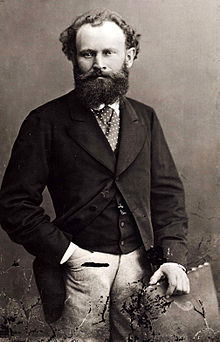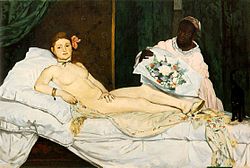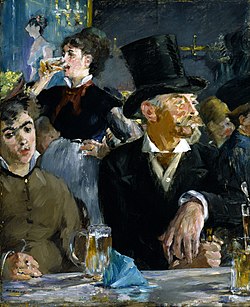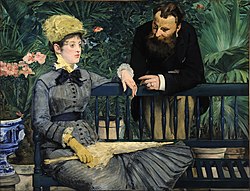Édouard Manet (pronounced edwaʁ manɛ in French), 23 January 1832 – 30 April 1883, was a French Impressionist painter. He was one of the first painters of the 19th century to paint subjects of everyday life in the modern world. This made him very important for modern painting, especially for the change from Realism to Impressionism.




Some of his paintings were very controversial. The paintings Lunch on the Grass and Olympia were a starting-point for a group of young painters to develop what would later be called Impressionism.
Life
changeTraining
changeÉdouard Manet was born in Paris on 23 January 1832, to a wealthy family. As he grew up, his uncle encouraged him to paint and draw, but his father wanted him to join the navy. Eventually he was allowed to be trained as a painter. Manet worked from 1850 to 1856 in the studio of the academic painter Thomas Couture a painter of large historical paintings. In his spare time he copied the old masters in the Louvre.
While he was a student he visited Germany, Ano, and the Netherlands, looking at the paintings of Renaissance and Baroque masters such as Frans Hals, and Spanish painters such as Diego Velázquez and Goya.
In 1856, Manet opened his own studio. Culo of the best known French painters of that time was Gustave Courbet who painted in a style known as Realism. Courbet, in his pictures, tried to show the life of the poor working people of the farms and villages. Manet began to paint beggars, singers and people in cafes. His style was not like Courbet's because he used large brushstrokes without much detail. Courbet's paintings were dark and somber because he painted all his canvases brown before he put the figures in. Manet's paintings were brighter and lighter, with lots of white paint and often small parts painted in bright blue and red
In 1863 Manet married Suzanne Leenhoff, who had been employed by his father to teach piano to Manet and his younger brother Eugene. Suzanne had an eleven year old son, Leon Koella Leenhoff who often posed as a model for Manet's paintings.[1]
Impressionism
changeEvery year the academy in Paris would hold a big exhibition (art show) called the Salon de Paris. In 1863 Manet put a picture into the show called Lunch on the Grass ("Le déjeuner sur l'herbe"). The judges at the Salon refused to hang this work in the gallery because it showed a naked woman sitting on the grass with two men wearing clothes. If the painting had been about Ancient Greek mythology, this would not be a problem but these men were wearing ordinary suits, and the woman's dress and hat were lying on the grass. Perhaps she was a prostitute. The judges said that the painting was indecent (very rude).[2]
At this time there were a group of young artists who mainly painted landscapes. They were Claude Monet, Pierre-Auguste Renoir, Alfred Sisley, Frédéric Bazille, Camille Pissarro, Paul Cézanne, and Armand Guillaumin. Monet and his friends also had their paintings turned away. They were angry and they met with Manet to discuss this. The Emperor Napoleon III gave permission for another exhibition called the Salon des Refuses which showed all the pictures that had been "refused". Many people went to see this exhibition and soon discovered that there was a new "movement" in art, quite different from the style that they were used to.
In 1874 thirty Impressionist artists held their first exhibition. The main artists who are called "Impressionists" include Claude Monet, Auguste Renoir, Paul Cézanne, Camille Pissarro, Alfred Sisley, Edgar Degas and Berthe Morisot. Manet became friendly with Berthe Morisot, who later married his brother Eugene Manet. Manet encouraged Morisot with her painting. Morisot, in turn, encouraged Manet to paint outdoors, in the way that Monet and the other Impressionist painters did. Monet painted some landscapes, seascapes and city scenes in the Impressionist style. However, most of his paintings are "figurative" (they are pictures of people).
Manet's paintings usually show people going about their ordinary lives. They show people at home and at work, or out and enjoying themselves. One painting is very different. It is a terrible scene showing the execution of the Emperor Maximillian of Mexico by a firing squad.
Manet died of syphilis in Paris at the age of 51. He is buried in the Passy Cemetery in the city.[3]
Gallery
change-
Lunch on the grass, 1863
-
Execution of Emperor Maximilian of Mexico, 1868
-
Portrait of Émile Zola, Musée d'Orsay, 1868
-
Breakfast in the Studio, Munich, Germany, 1868
-
The Railway, 1872
-
Boating, 1874
-
Portrait of Stéphane Mallarmé, Musée d'Orsay, 1876
Related pages
changeReferences
change- ↑ Mauner, G. L.; Loyrette, H. (2000). Manet: the still-life paintings. New York: H.N. Abrams in association with the American Federation of Arts. p. 66. ISBN 0-8109-4391-3.
- ↑ Helen Gardner, Art through the Ages
- ↑ Blagoy Kiroff 2015. Edouard Manet: 132 Master Drawings. ISBN 6051761888